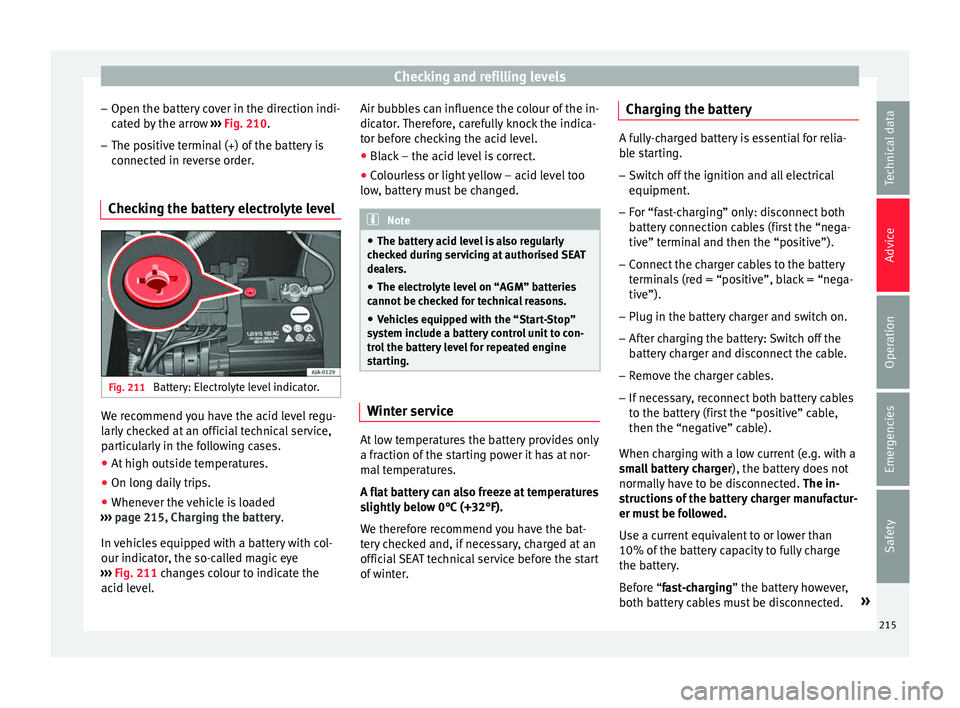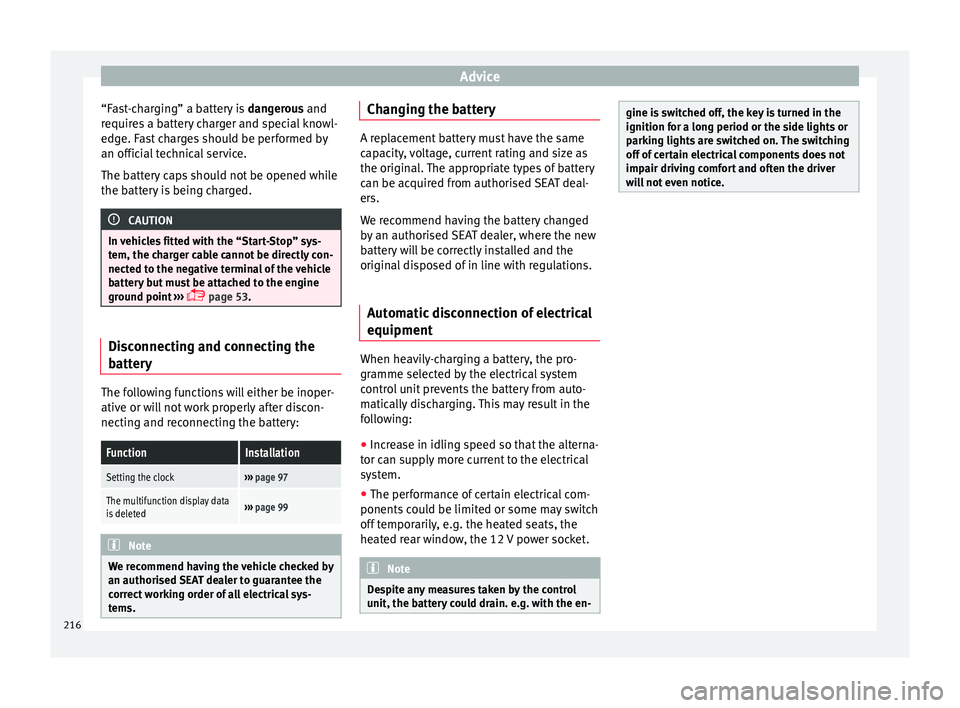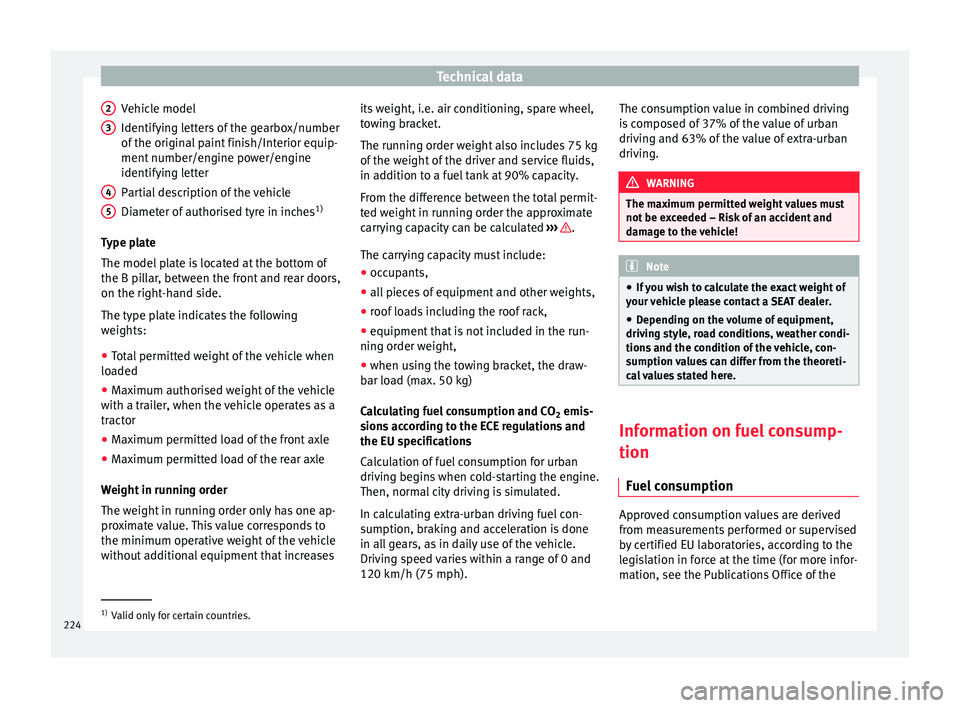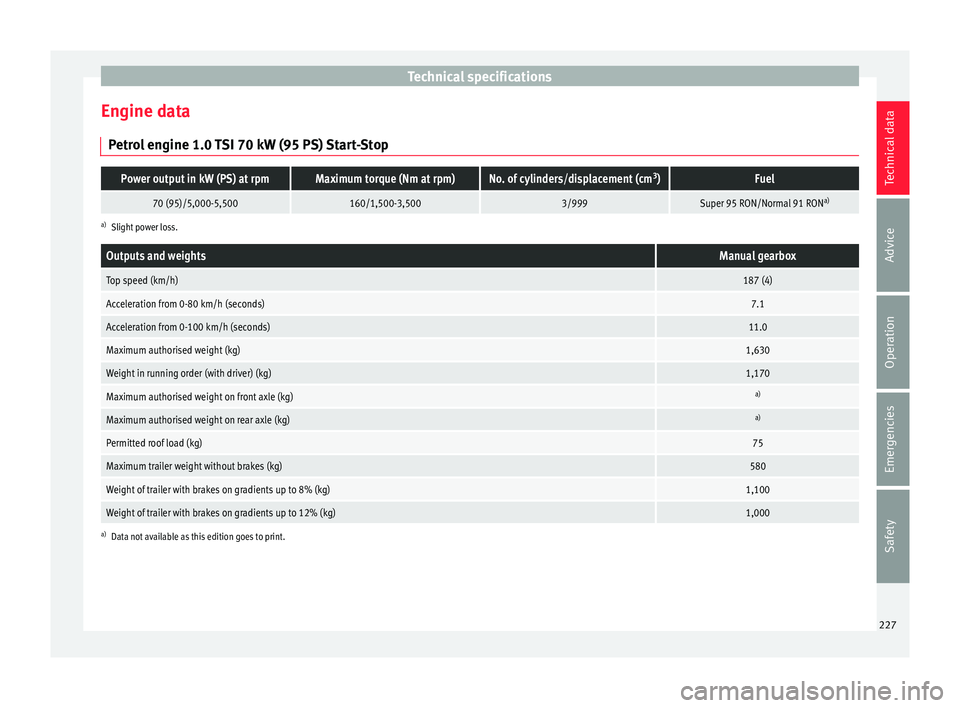engine Seat Toledo 2017 Manual Online
[x] Cancel search | Manufacturer: SEAT, Model Year: 2017, Model line: Toledo, Model: Seat Toledo 2017Pages: 248, PDF Size: 5.86 MB
Page 216 of 248

Advice
●
A short c
ircuit is produced if the battery ter-
minals are bridged, e.g. using metal objects,
cables, etc. Possible consequences of a short
circuit: melting of lead plates, battery explo-
sion and fire, splashing acid.
● The following is forbidden while working on
the batter
y: fire and open flames, smoking
and activities that could produce sparks.
Avoid causing sparks when handling cables
or electrical apparatus. Risk of injury in the
event of large sparks.
● Before working on the electrical system,
you mus
t switch off the engine, the ignition
and all electrical components and disconnect
the cable from the negative terminal (-) of the
battery. To change a bulb, simply switch off
the corresponding light.
● Never charge a frozen or thawed out bat-
tery
. Risk of explosion and acid burns! Re-
place a frozen battery.
● Never use the jump leads on batteries in
which the electr
olyte level is too low. Risk of
explosion and acid burns!
● Never use a damaged battery. Risk of ex-
plos
ion! Replace a damaged battery immedi-
ately. CAUTION
● Never di s
connect the battery when the igni-
tion is switched on, as the electrical system
(electronic components) of the vehicle could
be damaged. When disconnecting the battery
from the vehicle electrical system, disconnect its negative terminal (-) first. Only then may
the pos
itiv
e terminal (+) be disconnected.
● When connecting the battery, first connect
the positiv
e terminal (+) and then the nega-
tive terminal (-). The battery cables must nev-
er be connected to the wrong battery termi-
nals. Risk of burning the electrical installa-
tion!
● Make sure the battery acid does not come
into cont
act with the bodywork. Risk of paint-
work damage.
● Do not expose the battery to direct sunlight
to prot
ect it from ultraviolet radiation.
● If the vehicle is not used for 3 or 4 weeks,
the batter
y could run flat. This is because
some components use electricity even in
standby mode (e.g. control units). Prevent the
battery from running flat by disconnecting its
negative terminal or leave it charging at a low
current.
● If you frequently use the vehicle for short
trips, the batt
ery may not fully charge and
could run flat. For the sake of the environment
A flat battery is particularly harmful waste for
the env ir
onment. It must therefore be dis-
posed of according to current local law. Note
Replace a battery once it is older than 5
ye ar
s. Control lamp
If the
control lamp is illuminated while the
en gine i
s running, the battery is not charg-
ing.
Go to a technical service. Have the car's elec-
trical equipment inspected. CAUTION
Additionally, if the warning lamp lights up
whi
le driving, the warning lamp also lights
up (cooling system fault). Stop the vehicle
and switch off the engine – Risk of engine
damage! Lifting the battery cover
Fig. 210
Battery: Opening the cover. The battery is located beneath a plastic cover
in the en
gine c
omp
artment.
214
Page 217 of 248

Checking and refilling levels
– Open the b att
er
y cover in the direction indi-
cated by the arrow ››› Fig. 210.
– The positive terminal (+) of the battery is
connected in r
everse order.
Checking the battery electrolyte level Fig. 211
Battery: Electrolyte level indicator. We recommend you have the acid level regu-
l
arly
c
hecked at an official technical service,
particularly in the following cases.
● At high outside temperatures.
● On long daily trips.
● Whenever the vehicle is loaded
›››
page 215, Charging the battery.
In vehicles equipped with a battery with col-
our indicator, the so-called magic eye
››› Fig. 211 changes colour to indicate the
acid level. Air bubbles can influence the colour of the in-
dicator
. Therefore, carefully knock the indica-
tor before checking the acid level.
● Black – the acid level is correct.
● Colourless or light yellow – acid level too
low, b
attery must be changed. Note
● The batt er
y acid level is also regularly
checked during servicing at authorised SEAT
dealers.
● The electrolyte level on “AGM” batteries
cannot be c
hecked for technical reasons.
● Vehicles equipped with the “Start-Stop”
syst
em include a battery control unit to con-
trol the battery level for repeated engine
starting. Winter service
At low temperatures the battery provides only
a fr
action of
the s
tarting power it has at nor-
mal temperatures.
A flat battery can also freeze at temperatures
slightly below 0°C (+32°F).
We therefore recommend you have the bat-
tery checked and, if necessary, charged at an
official SEAT technical service before the start
of winter. Charging the battery A fully-charged battery is essential for relia-
bl
e s
tarting.
– Switch off the ignition and all electrical
equipment.
– For “f
ast-charging” only: disconnect both
batter
y connection cables (first the “nega-
tive” terminal and then the “positive”).
– Connect the charger cables to the battery
terminal
s (red = “positive”, black = “nega-
tive”).
– Plug in the battery charger and switch on.
– After charging the battery: Switch off the
batt er
y charger and disconnect the cable.
– Remove the charger cables.
– If necessary, reconnect both battery cables
to the batt
ery (first the “positive” cable,
then the “negative” cable).
When charging with a low current (e.g. with a
small battery charger ), the battery does not
normally have to be disconnected. The in-
structions of the battery charger manufactur-
er must be followed.
Use a current equivalent to or lower than
10% of the battery capacity to fully charge
the battery.
Before “fast-charging” the battery however,
both battery cables must be disconnected. »
215
Technical data
Advice
Operation
Emergencies
Safety
Page 218 of 248

Advice
“Fast-charging” a battery is dan
g erous and
requires a battery charger and special knowl-
edge. Fast charges should be performed by
an official technical service.
The battery caps should not be opened while
the battery is being charged. CAUTION
In vehicles fitted with the “Start-Stop” sys-
tem, the c h
arger cable cannot be directly con-
nected to the negative terminal of the vehicle
battery but must be attached to the engine
ground point ›››
page 53. Disconnecting and connecting the
b
att
er
y The following functions will either be inoper-
ativ
e or w
i
ll not work properly after discon-
necting and reconnecting the battery:
FunctionInstallation
Setting the clock››› page 97
The multifunction display data
is deleted››› page 99 Note
We recommend having the vehicle checked by
an authorised S EA
T dealer to guarantee the
correct working order of all electrical sys-
tems. Changing the battery
A replacement battery must have the same
cap
ac
ity, voltage, current rating and size as
the original. The appropriate types of battery
can be acquired from authorised SEAT deal-
ers.
We recommend having the battery changed
by an authorised SEAT dealer, where the new
battery will be correctly installed and the
original disposed of in line with regulations.
Automatic disconnection of electrical
equipment When heavily-charging a battery, the pro-
gr
amme sel
ect
ed by the electrical system
control unit prevents the battery from auto-
matically discharging. This may result in the
following:
● Increase in idling speed so that the alterna-
tor can s
upply more current to the electrical
system.
● The performance of certain electrical com-
ponents cou
ld be limited or some may switch
off temporarily, e.g. the heated seats, the
heated rear window, the 12 V power socket. Note
Despite any measures taken by the control
unit, the b att
ery could drain. e.g. with the en- gine is switched off, the key is turned in the
ignition for a lon
g period or the s
ide lights or
parking lights are switched on. The switching
off of certain electrical components does not
impair driving comfort and often the driver
will not even notice. 216
Page 225 of 248

Technical specifications
Technical data
T ec
hnic
al specifications
Important information Important The information in the vehicle documentation
alwa
y
s takes precedence over the informa-
tion in this Instruction Manual.
All technical specifications provided in this
documentation are valid for the standard
model in Spain. The vehicle data card inclu-
ded in the Maintenance Programme or the
vehicle registration documents shows which
engine is installed in the vehicle.
The figures may be different depending
whether additional equipment is fitted, for
different models, for special vehicles and for
other countries. Abbreviations used in the Technical Specifi-
cation
s
section
kWKilowatt, engine power measurement.
PSPferdestärke (horsepower), formerly
used to denote engine power.
rpmRevolutions per minute - engine speed.
NmNewton metres, unit of engine torque.
CZCetane number, indication of the diesel
combustion power.
RONResearch octane number, indication of
the knock resistance of petrol. Vehicle identification data
Fig. 216
Data sticker. Fig. 217
Chassis number. VIN in the Easy Connect
● Select:
button > function button SET-
TINGS > Service > Chassis number .
Ch a
s
sis number
The VIN is located in the Easy Connect, on the
vehicle data sticker and under the wind-
screen, on the driver side ››› Fig. 217. Addi-
tionally, the chassis number is located in the
engine compartment, on the right-hand side.
The number is engraved on the top side rail,
and is partially covered.
Vehicle data label
The vehicle data sticker ››› Fig. 216 is located
on the boot floor and is also attached to the
Maintenance Programme.
The following information is provided on the
vehicle data sticker:
Vehicle identification number (VIN) »
1 223
Technical data
Advice
Operation
Emergencies
Safety
Page 226 of 248

Technical data
Vehicle model
Identif y
in
g letters of the gearbox/number
of the original paint finish/Interior equip-
ment number/engine power/engine
identifying letter
Partial description of the vehicle
Diameter of authorised tyre in inches 1)
Type plate
The model plate is located at the bottom of
the B pillar, between the front and rear doors,
on the right-hand side.
The type plate indicates the following
weights:
● Total permitted weight of the vehicle when
loaded
● M
aximum authorised weight of the vehicle
with a trai
ler, when the vehicle operates as a
tractor
● Maximum permitted load of the front axle
● Maximum permitted load of the rear axle
Weight in ru
nning order
The weight in running order only has one ap-
proximate value. This value corresponds to
the minimum operative weight of the vehicle
without additional equipment that increases 2 3
4
5 its weight, i.e. air conditioning, spare wheel,
t
o
w
ing bracket.
The running order weight also includes 75 kg
of the weight of the driver and service fluids,
in addition to a fuel tank at 90% capacity.
From the difference between the total permit-
ted weight in running order the approximate
carrying capacity can be calculated ››› .
The c arr
y
ing capacity must include:
● occupants,
● all pieces of equipment and other weights,
● roof loads including the roof rack,
● equipment that is not included in the run-
ning order w
eight,
● when using the towing bracket, the draw-
bar loa
d (max. 50 kg)
Calculating fuel consumption and CO 2 emis-
sions according to the ECE regulations and
the EU specifications
Calculation of fuel consumption for urban
driving begins when cold-starting the engine.
Then, normal city driving is simulated.
In calculating extra-urban driving fuel con-
sumption, braking and acceleration is done
in all gears, as in daily use of the vehicle.
Driving speed varies within a range of 0 and
120 km/h (75 mph). The consumption value in combined driving
is c
omposed of 37% of the value of urban
driving and 63% of the value of extra-urban
driving. WARNING
The maximum permitted weight values must
not be e x
ceeded – Risk of an accident and
damage to the vehicle! Note
● If y
ou wish to calculate the exact weight of
your vehicle please contact a SEAT dealer.
● Depending on the volume of equipment,
driving s
tyle, road conditions, weather condi-
tions and the condition of the vehicle, con-
sumption values can differ from the theoreti-
cal values stated here. Information on fuel consump-
tion
Fuel
c
onsumption Approved consumption values are derived
fr
om me
a
surements performed or supervised
by certified EU laboratories, according to the
legislation in force at the time (for more infor-
mation, see the Publications Office of the 1)
Valid only for certain countries.
224
Page 229 of 248

Technical specifications
Engine data P etr
o
l engine 1.0 TSI 70 kW (95 PS) Start-Stop
Power output in kW (PS) at rpmMaximum torque (Nm at rpm)No. of cylinders/displacement (cm 3
)Fuel
70 (95)/5,000-5,500160/1,500-3,5003/999Super 95 RON/Normal 91 RON a)
a)
Slight power loss.
Outputs and weightsManual gearbox
Top speed (km/h)187 (4)
Acceleration from 0-80 km/h (seconds)7.1
Acceleration from 0-100 km/h (seconds)11.0
Maximum authorised weight (kg)1,630
Weight in running order (with driver) (kg)1,170
Maximum authorised weight on front axle (kg)a)
Maximum authorised weight on rear axle (kg)a)
Permitted roof load (kg)75
Maximum trailer weight without brakes (kg)580
Weight of trailer with brakes on gradients up to 8% (kg)1,100
Weight of trailer with brakes on gradients up to 12% (kg)1,000
a)
Data not available as this edition goes to print. 227
Technical data
Advice
Operation
Emergencies
Safety
Page 230 of 248

Technical data
Petrol engine 1.0 TSI 81 kW (110 PS) Start-StopPower output in kW (PS) at rpmMaximum torque (Nm at rpm)No. of cylinders/displacement (cm 3
)Fuel
81 (110)/5,000-5,500200/2,000-3,5003/999Super 95 RON/Normal 91 RON a)
a)
Slight power loss.
Outputs and weightsManual gearbox
Top speed (km/h)200 (5)
Acceleration from 0-80 km/h (seconds)6.6
Acceleration from 0-100 km/h (seconds)9.8
Maximum authorised weight (kg)1,650
Weight in running order (with driver) (kg)1,190
Maximum authorised weight on front axle (kg)a)
Maximum authorised weight on rear axle (kg)a)
Permitted roof load (kg)75
Maximum trailer weight without brakes (kg)590
Weight of trailer with brakes on gradients up to 8% (kg)1,200
Weight of trailer with brakes on gradients up to 12% (kg)1,100
a)
Data not available as this edition goes to print. 228
Page 231 of 248

Technical specifications
Petrol engine 1.6 81 kW (110 PS)Power output in kW (PS) at rpmMaximum torque (Nm at rpm)No. of cylinders/displacement (cm 3
)Fuel
81 (110)/5,800155/3,800-4,0004/1,598Super 95 RON/Normal 91 RON a)
a)
Slight power loss.
Outputs and weightsManual gearboxAutomatic
Top speed (km/h)191 (5)191 (6)
Acceleration from 0-80 km/h (seconds)6.77.7
Acceleration from 0-100 km/h (seconds)10.311.5
Maximum authorised weight (kg)1,6351,675
Weight in running order (with driver) (kg)1,1751,215
Maximum authorised weight on front axle (kg)820860
Maximum authorised weight on rear axle (kg)840840
Permitted roof load (kg)7575
Maximum trailer weight without brakes (kg)580600
Weight of trailer with brakes on gradients up to 8% (kg)1,1001,100
Weight of trailer with brakes on gradients up to 12% (kg)1,0001,000 229
Technical data
Advice
Operation
Emergencies
Safety
Page 232 of 248

Technical data
Petrol engine 1.4 TSI 92 kW (125 PS)Power output in kW (PS) at rpmMaximum torque (Nm at rpm)No. of cylinders/displacement (cm 3
)Fuel
92 (125)/5,000-6,000200/1,400-4,0004/1,395Super 95 RON/Normal 91 RON a)
a)
Slight power loss.
Outputs and weightsAutomatic
Start-StopAutomatic
Ecomotive
Top speed (km/h)208 (6)208 (6)
Acceleration from 0-80 km/h (seconds)6.36.4
Acceleration from 0-100 km/h (seconds)99
Maximum authorised weight (kg)1,6961,687
Weight in running order (with driver) (kg)1,2361,227
Maximum authorised weight on front axle (kg)880880
Maximum authorised weight on rear axle (kg)830830
Permitted roof load (kg)7575
Maximum trailer weight without brakes (kg)600610
Weight of trailer with brakes on gradients up to 8% (kg)1,2001,200
Weight of trailer with brakes on gradients up to 12% (kg)1,2001,200 230
Page 233 of 248

Technical specifications
Diesel Engine 1.4 CR 66 kW (90 PS)Power output in kW (PS) at rpmMaximum torque (Nm at rpm)No. of cylinders/displacement (cm 3
)Fuel
66 (90)/3,500230/1,750-2,5004/1,422Diesel according to standard EN 590, min.
51 CZ
Outputs and weightsManual gearbox
EcomotiveAutomatic
Ecomotive
Top speed (km/h)185 (5)185 (7)
Acceleration from 0-80 km/h (seconds)88.2
Acceleration from 0-100 km/h (seconds)11.711.8
Maximum authorised weight (kg)1,7041,725
Weight in running order (with driver) (kg)1,2441,265
Maximum authorised weight on front axle (kg)890910
Maximum authorised weight on rear axle (kg)840840
Permitted roof load (kg)7575
Maximum trailer weight without brakes (kg)610620
Weight of trailer with brakes on gradients up to 8% (kg)1,1001,100
Weight of trailer with brakes on gradients up to 12% (kg)7501,000 231
Technical data
Advice
Operation
Emergencies
Safety